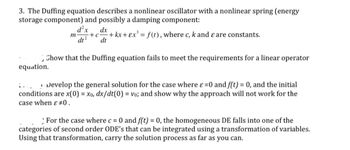
Elements Of Electromagnetics
7th Edition
ISBN: 9780190698614
Author: Sadiku, Matthew N. O.
Publisher: Oxford University Press
expand_more
expand_more
format_list_bulleted
Question

Transcribed Image Text:3. The Duffing equation describes a nonlinear oscillator with a nonlinear spring (energy
storage component) and possibly a damping component:
equation.
m
i
d²x
dt2 2
+c
dx
+ kx + εx³ = f(t), where c, k and & are constants.
dt
Chow that the Duffing equation fails to meet the requirements for a linear operator
Develop the general solution for the case where & =0 and f(t) = 0, and the initial
conditions are x(0) = xo, dx/dt(0) = vo; and show why the approach will not work for the
case when �.
For the case where c = 0 and f(t) = 0, the homogeneous DE falls into one of the
categories of second order ODE's that can be integrated using a transformation of variables.
Using that transformation, carry the solution process as far as you can.
Expert Solution
This question has been solved!
Explore an expertly crafted, step-by-step solution for a thorough understanding of key concepts.
This is a popular solution
Trending nowThis is a popular solution!
Step by stepSolved in 4 steps

Knowledge Booster
Similar questions
- answer completely and neatlyarrow_forwardFor point a, suggest a different form but the same equation without removing uarrow_forwardT C We consider a rotating shaft. A torque T is applied, resuting in a rotation of the shaft. The bearing system and the output connections yield a viscous damping torque D. T: input torque 2: output angular velocity Dan: viscous damping = J: moment of inertia Governing equation (obtained using Euler equation for rotating solids): JN+an = T αΩarrow_forward
- 2. For the circuit below, utilize only the node-voltage method: Vb + V1 R1 3la + R4 ww Va R3 V2 V3 ww R2 R5 RE Setup the equations needed to solve for V1, V2, and V3. Please also include an expression to solve for current Iд.arrow_forwardclear explanation pleasearrow_forwardThe state z(t) of a dynamical system is solution of equation ż(t) + aż(t) + 25z(t) = 12, with a = 7.3. Calculate the Peak time of the response.arrow_forward
arrow_back_ios
arrow_forward_ios
Recommended textbooks for you
 Elements Of ElectromagneticsMechanical EngineeringISBN:9780190698614Author:Sadiku, Matthew N. O.Publisher:Oxford University Press
Elements Of ElectromagneticsMechanical EngineeringISBN:9780190698614Author:Sadiku, Matthew N. O.Publisher:Oxford University Press Mechanics of Materials (10th Edition)Mechanical EngineeringISBN:9780134319650Author:Russell C. HibbelerPublisher:PEARSON
Mechanics of Materials (10th Edition)Mechanical EngineeringISBN:9780134319650Author:Russell C. HibbelerPublisher:PEARSON Thermodynamics: An Engineering ApproachMechanical EngineeringISBN:9781259822674Author:Yunus A. Cengel Dr., Michael A. BolesPublisher:McGraw-Hill Education
Thermodynamics: An Engineering ApproachMechanical EngineeringISBN:9781259822674Author:Yunus A. Cengel Dr., Michael A. BolesPublisher:McGraw-Hill Education Control Systems EngineeringMechanical EngineeringISBN:9781118170519Author:Norman S. NisePublisher:WILEY
Control Systems EngineeringMechanical EngineeringISBN:9781118170519Author:Norman S. NisePublisher:WILEY Mechanics of Materials (MindTap Course List)Mechanical EngineeringISBN:9781337093347Author:Barry J. Goodno, James M. GerePublisher:Cengage Learning
Mechanics of Materials (MindTap Course List)Mechanical EngineeringISBN:9781337093347Author:Barry J. Goodno, James M. GerePublisher:Cengage Learning Engineering Mechanics: StaticsMechanical EngineeringISBN:9781118807330Author:James L. Meriam, L. G. Kraige, J. N. BoltonPublisher:WILEY
Engineering Mechanics: StaticsMechanical EngineeringISBN:9781118807330Author:James L. Meriam, L. G. Kraige, J. N. BoltonPublisher:WILEY

Elements Of Electromagnetics
Mechanical Engineering
ISBN:9780190698614
Author:Sadiku, Matthew N. O.
Publisher:Oxford University Press

Mechanics of Materials (10th Edition)
Mechanical Engineering
ISBN:9780134319650
Author:Russell C. Hibbeler
Publisher:PEARSON

Thermodynamics: An Engineering Approach
Mechanical Engineering
ISBN:9781259822674
Author:Yunus A. Cengel Dr., Michael A. Boles
Publisher:McGraw-Hill Education

Control Systems Engineering
Mechanical Engineering
ISBN:9781118170519
Author:Norman S. Nise
Publisher:WILEY

Mechanics of Materials (MindTap Course List)
Mechanical Engineering
ISBN:9781337093347
Author:Barry J. Goodno, James M. Gere
Publisher:Cengage Learning

Engineering Mechanics: Statics
Mechanical Engineering
ISBN:9781118807330
Author:James L. Meriam, L. G. Kraige, J. N. Bolton
Publisher:WILEY